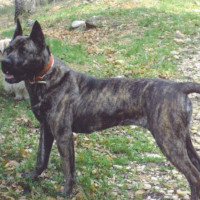Appearance of the Basque Ratier
|
| This elusive dog, the Basque Ratier, is an enigma. Information on their size and weight is incomplete at best. The consensus is that they are small to medium-sized dogs, but their average weight is between 26 and 29 kg, making them almost Labrador-sized. Likewise, with their height over half a meter from the shoulder, this makes them unusually leggy for a small dog. But what's agreed is their coat, which is said to be short and smooth. And, as for coat color, the breed is traditionally brown, except on the belly where it tends to be yellow or cream. As for proportions, they have much in common with other Terriers in that they have a well-proportioned muzzle, all the better for spotting rats, a robust body and working-length legs. |
Temperament of the Basque Ratier
|
| The Basque Ratier has a reputation for being calm and intelligent. Calm, that is, until a stranger calls how loud and piercing their bark is. As hunting dogs, they're used to living on their wits and making decisions. This makes sense, as a dog that has to wait for its master's instructions to catch a vicious rat won't succeed in the long run. The low numbers of Basque Ratiers seem to indicate that their niche is indeed hunting. However, the limited information available suggests that they make good pets in the right hands. The latter is probably a cat- and rabbit-free household, as the hunting instinct of any Ratier means that their strong prey drive makes them uncomfortable with other small mammals. |
Needs and activities of the Basque Ratier
|
| Dogs bred for work have a high requirement for exercise and mental stimulation. The Basque Ratier is no exception. They should be given generous physical exercise every day, not just at weekends. For example, two one-hour walks a day are a minimum. They also need enough free time to explore and follow the scents. As for mental stimulation, this can be provided in part through training sessions, which encourage the dog to concentrate. But also, they should have plenty of opportunities to play and smell interesting scents. Puzzle feeders are another way of providing mental work, as these dogs will enjoy solving a puzzle in order to obtain food. An owner who fails to provide sufficient mental stimulation or exercise risks seeing his dog develop bad habits. A Basque Ratier may well use his superfluous energy to allow him to board, dig or chew excessively. Indeed, lack of exercise will quickly lead to weight gain and obesity. |
Maintenance of the Basque Ratier
|
| The Basque Ratier's short coat is very easy to care for. All they need is a good brushing once a week to keep their coat in good condition. However, don't be tempted to skip this once-a-week attention. Not only does it spread natural conditioning oils that keep the coat smooth and shiny, it also removes dead hairs. This is a boon for the Basque Ratier pet owner who might otherwise find their upholstery adorned with dog hair. |







 English (United Kingdom)
English (United Kingdom)